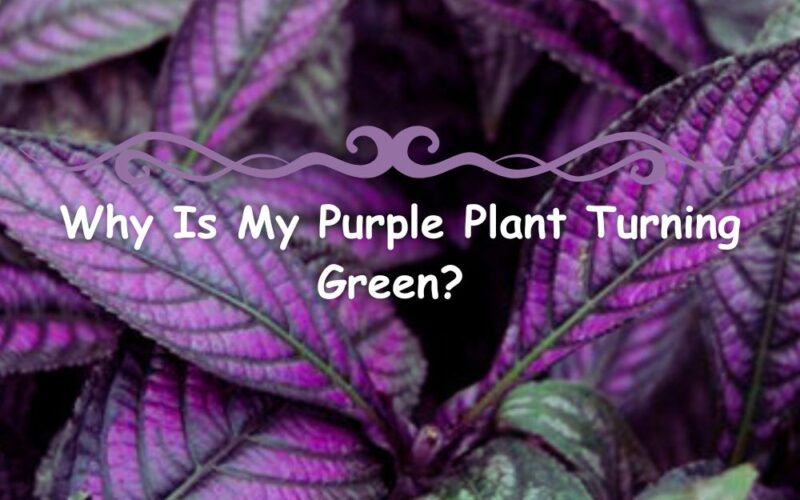Why is my coleus turning green? I bought a luxury black rose succulent but it is turning green! why? and many other frequent questions that people often ask me about purple plant turning green. Based on my experiences, it is often due to the dance of light in various seasons or places. Here I will tell you the reasons for these colour transforming.
I have PhD in Plant protection science and work as a horticultural counsellor. I’m with you in this post to tell you the reason for this phenomenon. I will answer your concerns. After reading it, you will learn how to keep the purple colour of your luxury indoor plant. I will talk with you about the world of plant pigments, environmental influences, and care practices. Keep reading to start our colourful journey!

Understanding the Enigma Transition Purple to Green
Why do purple plants sometimes forsake their regal plumage for a more conventional green attire? To grasp this transformation, we need to dig into the science of plant pigments. The captivating hues of purple plants are primarily attributed to pigments called anthocyanins.
These pigments produce colors ranging from deep purples and red plants to vibrant blues, depending on the pH levels in plant cells. However, environmental factors and genetic predispositions can trigger changes in these pigments, leading to the shift from purple to green.
Reasons Behind the Transformation purple leaves to green
-
Chlorophyll Takeover

Imagine your plant as a chameleon trying to adapt to its surroundings. When a purple plant turns green, it’s often due to an increase in chlorophyll production. Chlorophyll, the essential pigment responsible for photosynthesis, has a distinct green color. Environmental changes, such as increased sunlight exposure or nutrient availability, can stimulate chlorophyll production.
As a result, the plant prioritizes green pigments for efficient photosynthesis, overpowering the anthocyanins responsible for the purple shades. For instance, a purple-leafed Heuchera plant may turn green under prolonged periods of intense sunlight, as chlorophyll becomes the plant’s superhero for survival.
-
Seasonal Transformations
Just like the changing seasons impact our moods, they also influence plants. Many purple plants exhibit a natural color transition as part of their seasonal rhythm. During colder months or periods of stress, plants might concentrate energy on essential functions rather than maintaining vibrant pigments.
As winter approaches, the vibrant purples of the smokebush (Cotinus coggygria) might mellow into a subtle green, signalling the plant’s readiness for a period of dormancy. This adaptive strategy helps plants conserve resources and ensure their long-term survival.
-
Genetic Quirks

Genes hold the blueprint of life – and sometimes, they surprise us. Genetic mutations can play a pivotal role in altering a plant’s color palette. Some purple plants might possess genetic variations that make them prone to changing pigments under specific conditions.
These mutations could make the production of anthocyanins more sensitive to environmental factors, leading to shifts in coloration. The Japanese maple (Acer palmatum), celebrated for its graceful foliage, can occasionally exhibit green leaves among its purple counterparts due to genetic diversity within its species.
-
Nurturing Your Purple Plant
Now that we’ve uncovered the reasons behind the color shift, let’s explore how to care for your purple plants to maintain their striking hues. While some color changes are inevitable and natural, you can follow these tips to enhance the vibrancy of your purple-leafed companions:
Sunlight Balance: Place your purple plant where it receives the right amount of sunlight – not too much to trigger excessive chlorophyll production, and not too little to weaken the anthocyanin pigments.
Nutrient Care: Ensure your plant gets the appropriate nutrients, as deficiencies can prompt color changes. Regular fertilization with a balanced formula can help maintain the plant’s health and color.
In the following video, you can watch ” Why Your Purple Plant Turning Green?”
The Dance of Light: Illuminating the Color Transition
Imagine light as a master painter, delicately adding shades to the canvas of nature. When it comes to the transformation of purple plants into green, the role of light is as crucial as it is mesmerizing. Light acts as a catalyst, triggering a series of intricate biochemical reactions within plant cells.
These reactions dictate not only the plant’s growth but also its vibrant color display. Let’s delve into how light influences the transition of purple plants to green and unravel the secrets of this captivating interplay.
The Light Spectrum and Photosynthesis
Have you ever wondered why plants crave sunlight? The answer lies in the process of photosynthesis. Sunlight is composed of various colors, each corresponding to a specific wavelength. Chlorophyll, the primary pigment responsible for photosynthesis, absorbs light most efficiently in the blue and red regions of the spectrum.
This absorption drives the conversion of carbon dioxide and water into glucose, the plant’s energy source. When a purple plant is exposed to ample sunlight, chlorophyll production increases to optimize photosynthesis, which in turn can overpower the anthocyanin pigments, leading to the shift from purple to green.
Balance and Sunlight Intensity
Think of sunlight as a nurturing embrace – too little, and the plant yearns for more; too much, and it might feel overwhelmed. Achieving the right balance of sunlight is essential in maintaining the vibrant hues of purple plants. Insufficient sunlight can limit photosynthesis, prompting the plant to prioritize energy conservation over colorful pigments.
On the other hand, excessive sunlight can lead to chlorophyll dominance, causing the transformation to green and presenting a green and purple leaves plant. By understanding your plant’s light requirements and adjusting its exposure accordingly, you can help maintain the delicate equilibrium between purple and green. some plants can thrive in low-light conditions and some need a more bright places.
Shifting Seasons and Light’s Influence

Just as the angle of light changes with the seasons, so does its impact on plant coloration. Seasons bring about fluctuations in light intensity and duration. During warmer months, when sunlight is abundant, plants gear up for growth and reproduction. This can result in a shift towards green as chlorophyll takes center stage.
As the days grow shorter and temperatures drop, plants shift their focus to conserving energy for the winter. This transition can lead to the resurgence of anthocyanin pigments, bringing back the regal purples and even causing a dark purple plant. Thus, the changing dance of light throughout the year contributes to the dynamic color shifts of purple plants.
Nurturing Color Through Light
In the realm of plant care, understanding the influence of light is like holding the key to an artist’s palette. To nurture the color vibrancy of your purple plants, consider these tips:
Sunlight Exposure: Research the specific light requirements of your plant species. Provide it with the appropriate amount of sunlight, considering factors such as intensity, duration, and any shading needs.
Natural Rhythms: Be mindful of seasonal changes and adjust your plant care routine accordingly. During periods of growth, ensure the plant receives adequate light to support its energy needs.
Artificial Lighting: If natural light is limited, consider using artificial grow lights that emit wavelengths conducive to photosynthesis. This can help maintain plant health and coloration.
Conclusion
Now, you found out the enigma of the transition of purple leaves to green. From now on when you spot your purple houseplant is transferred to a shade of green, you will welcome the change as a testament to the plant’s resilience and adaptability. In addition, you learned how to care for your indoor plant to keep its purple leaves for more time.
can you add other ways to keep the purple hue of your indoor plant? In the following, you will find out some of the common questions that people usually ask about purple plants. if you have any questions, you ask me below this page.
Most Common Asked Questions about Purple Plant Turning Green

Q1: Can I prevent my purple plant from turning green?
A: While some color changes are natural, proper care can minimize abrupt shifts. Maintain a balanced environment with the right sunlight, nutrients, and care to preserve the plant’s purple hues.
Q2: Will a green-purple plant revert to its original color?
A: In some cases, yes. As environmental conditions change, the plant might regain its purple shades. However, genetic factors and seasonal variations can influence this outcome.
Q3: Are there plants that intentionally change color for survival?
A: Yes, some plants adopt color changes as a survival strategy. For example, certain arctic plants turn red to protect themselves from harsh sunlight.
Q4: Is stress a significant factor in color changes?
A: Stress can contribute to color shifts, but it’s not the sole factor. Other aspects like genetics and environmental changes also play a crucial role.
Q5: Can I use fertilizers to maintain my plant’s color?
A: While fertilizers can support plant health, excessive use can backfire and lead to unwanted color changes. Follow recommended guidelines for fertilization.
Q6: Do all purple plants have the potential to turn green?
A: Not all purple plants will turn green. You will spot this phenomenon more in some plants due to the genetic factors that cause their sensitivity to environmental factors.
Q7: Can I manipulate the pH of the soil to preserve purple coloration?
A: Soil pH can influence plant pigments, but altering it significantly might have unintended consequences on overall plant health. It’s best to focus on balanced care.
Q8: Should I be concerned about my plant’s health when it changes color?
A: Mild color changes are usually a natural response to environmental shifts. However, if color changes are accompanied by other signs of distress like wilting or leaf damage, it’s worth investigating potential issues.

Elahe Rabiei
Hi, I’m Elaheh. My Academic major is plant protection, and houseplants are my expertise. As a houseplant lover, my house is full of indoor plants and it is my passion to take care of them. Hence, I’m here to share my knowledge and experience about growing healthy houseplants. I am also a plant protection advisor, so feel free to ask me any questions you may have.

